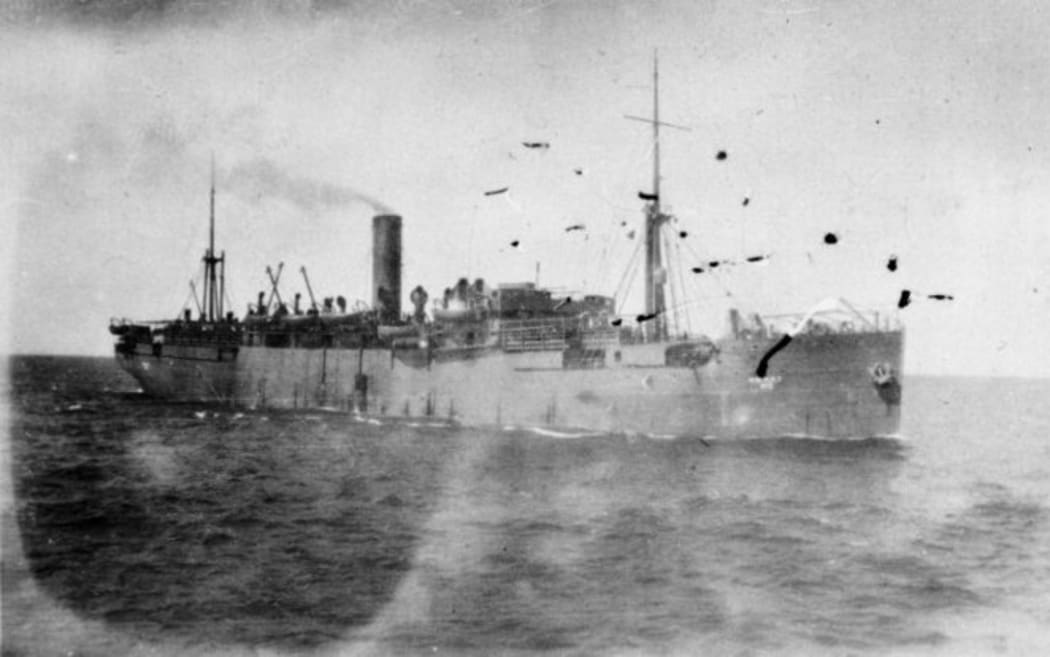Commemorations begin in in Australia tonight marking 100 years since some 30,000 New Zealand and Australian troops left a Western Australian port for the battlefields of WWI.

Troop transport SS Waimana on its way from Auckland to Egypt in 1914. Photo: National Library Ref: PA1-o-573-11-1
Four days of events start in the port city of Albany tonight. A New Zealand delegation, including Prime Minister John Key and about 40 Defence Force personnel, will take part in a memorial service tomorrow, the 100th anniversary of the day the troops left.
Navy frigate HMNZS Te Kaha will join Australian ships for a symbolic re-enactment of the first convoy's departure.
The New Zealand convoy in 1914 consisted of ten merchant ships, carrying 8568 soldiers and officers and 3820 horses.
In an interview in 1976, Cyril Bassett explained what it was like aboard the SS Waimana.
"The Waimana was full of troops and horses. In fact, so much so, that it was very hard to get sitting space. And I was arrested one day for sitting on a sack of spuds!
"When we got into bad weather, there were horses falling down and everybody being sick. We never knew whether we were going to be attacked."
The convoy did run into conflict, just nine days after leaving Albany.
HMAS Sydney shot away in pursuit of a German raider, SMS Emden, and ran it aground.
Ernest Boston was the captain's messenger aboard HMAS Sydney.
He told an interviewer in 1980 how the German captain, Karl Muller, reacted after being captured.
"We came up on deck and he said, boy, what's all this? I said, that's the 28 transports with the Australians and New Zealanders. He thought a minute and he said, it'll go hard for the Fatherland if all the minions rally to their England like this."
The editor of encyclopedia Te Ara, Jock Phillips, said 1 November 1914 marked the beginning of a long tradition of New Zealanders and Australians fighting side by side.
"It was the first time that the New Zealanders had felt they were part of a larger imperial force."
The term Anzac did not emerge until later that year when a New Zealand clerk coined the abbreviation to save time, and so created an eduring acronym.
But Mr Phillips said the two forces didn't get along right away.
"You get a lot of comments in New Zealand diaries about how these Australians aren't very well behaved and they've got to learn a thing or two. And it wasn't really until they got to Gallipoli that the attitude changed and the famous Anzac spirit emerged."
The four day commemoration in Albany tonight begins with a sunset ceremony. The small city, of almost 40,000, is bracing itself for an expected 60,000 visitors.
New Zealand Prime Minister John Key will speak at a commemorative service tomorrow, after a troop march including New Zealand and Australian defence force personnel.
Then a flotilla of ships, including HMNZS Te Kaha, will reenact the first convoy's departure.
Albany mayor Dennis Wellington said the event would pay tribute to the thousands who died while at the same time highlighting the futility of war.
"I don't think we've learnt too much in the last 100 years. The only thing we've really learnt is to find better ways to kill each other. So what we're trying to do is let people be aware we don't want this sort of thing to happen again."
Leaders to discuss IS
Mr Key will have dinner with Australian Prime Minister Tony Abbott tonight during which the leaders are expected to discuss global threats such as the fight against Islamic State and possible joint initiatives to combat the threat of Ebola.
Mr Key is expected to announce within a few weeks, what role New Zealand will play in the US-led campaign against Islamic State in Syria and Iraq.
He said as part of its decision, the government is considering the response of like-minded countries, such as Australia.

